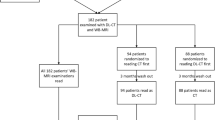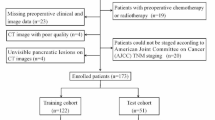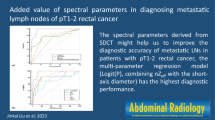Abstract
Purpose
To investigate the value of preoperative diagnosis of colorectal adenocarcinoma (CRAC) pathological T staging based on dual-layer spectral-detector computed tomography (DLCT) extracellular volume fraction (ECV) of CRAC lesions.
Methods
We prospectively collected clinical and DLCT imaging data from 165 patients with CRAC who attended two hospitals from June 2022 to April 2023. The enrolled patients were divided into a training group (n = 110, from Hospital 1) and an external validation group (n = 55, from Hospital 2). Measuring and calculating DLCT parameters of lesions, including CT values of 40 and 100 keV virtual mono-energetic images (VMI), iodine concentration (IC) and effective atomic number (Eff-Z) in the arterial phases (AP) and venous phases (VP), and ECV in the delayed phase (DP). The differences in clinical characteristics and DLCT parameters were compared between different pT subgroups. The correlation between DLCT parameters and pT stages were evaluated by Spearman correlation analysis. A multifactorial binary logistic stepwise forward regression analysis was performed to obtain independent influences associated with pT stage. Receiver operating characteristic curves (ROCs) were used to assess diagnostic efficacy and were expressed as area under the curve (AUC).
Results
Each DLCT parameter was higher in pT3 stage tumors than in pT1-2 stage tumors (all P < 0.05). The highest correlation was found between ECV and pT stage (r = 0.637). ECV were independent influences associated with pT stage. ECV had excellent diagnostic efficacy for CRAC pT staging in both the training and external validation groups (AUC = 0.919 and 0.892).
Conclusion
ECV based on DLCT measurement can be used for preoperative noninvasive diagnosis of CRAC pT staging with excellent diagnostic efficacy. It can provide a new imaging marker for the preoperative evaluation of CRAC and help clinicians formulate individualized treatment earlier. However, it needs to be confirmed with a larger sample size.




Similar content being viewed by others
References
Siegel RL, Miller KD, Wagle NS, Jemal A. Cancer statistics, 2023. CA Cancer J Clin. 2023;73(1):17–48.
Ferlay J, Colombet M, Soerjomataram I, et al. Estimating the global cancer incidence and mortality in 2018: GLOBOCAN sources and methods. Int J Cancer. 2019;144(8):1941–53.
Marks KM, West NP, Morris E, Quirke P. Clinicopathological, genomic and immunological factors in colorectal cancer prognosis. Br J Surg. 2018;105(2):e99–109.
Arredondo J, Baixauli J, Pastor C, et al. Mid-term oncologic outcome of a novel approach for locally advanced colon cancer with neoadjuvant chemotherapy and surgery. Clin Transl Oncol. 2017;19(3):379–85.
Kim S, Huh JW, Lee WY, et al. Oncologic outcomes of pathologic T4 and T3 colon cancer patients diagnosed with clinical T4 stage disease using preoperative computed tomography scan. Surg Oncol. 2022;41: 101749.
Nurkin S. Neoadjuvant treatment approaches for stage II–III rectal cancer. J of the Natl Compr Cancer Netw. 2023. https://doi.org/10.6004/jnccn.2023.5010.
Benson AB, Venook AP, Al-Hawary MM, et al. Rectal cancer, version 2 2022, NCCN clinical practice guidelines in oncology. J Natl Compr Canc Netw. 2022;20(10):1139–67.
Horvat N, Carlos Tavares Rocha C, Clemente Oliveira B, Petkovska I, Gollub MJ. MRI of rectal cancer: tumor staging, imaging techniques, and management. Radiogr. 2019. https://doi.org/10.1148/rg.2019180114.
Taylor FG, Swift RI, Blomqvist L, Brown G. A systematic approach to the interpretation of preoperative staging MRI for rectal cancer. AJR Am J Roentgenol. 2008;191(6):1827–35.
Danihel L Jr, Danihel L Sr, Rajcok M, et al. Significance of MRI in rectal carcinoma therapy optimization - correlation of preoperative T- and N-staging with definitive histopathological findings. Neoplasma. 2019;66(3):494–8.
Fulton N, Rajiah P. Abdominal applications of a novel detector-based spectral CT. Curr Probl Diagn Radiol. 2018;47(2):110–8.
Hojjati M, Van Hedent S, Rassouli N, et al. Quality of routine diagnostic abdominal images generated from a novel detector-based spectral CT scanner: a technical report on a phantom and clinical study. Abdom Radiol (NY). 2017;42(11):2752–9.
Chen W, Ye Y, Zhang D, et al. Utility of dual-layer spectral-detector CT imaging for predicting pathological tumor stages and histologic grades of colorectal adenocarcinoma. Front Oncol. 2022;12:1002592.
Hansen TF, Nielsen BS, Jakobsen A, Sørensen FB. Visualising and quantifying angiogenesis in metastatic colorectal cancer : a comparison of methods and their predictive value for chemotherapy response. Cell Oncol (Dordr). 2013;36(4):341–50.
Uzzan B, Nicolas P, Cucherat M, Perret GY. Microvessel density as a prognostic factor in women with breast cancer: a systematic review of the literature and meta-analysis. Cancer Res. 2004;64(9):2941–55.
den Uil SH, van den Broek E, Coupé V, et al. Prognostic value of microvessel density in stage II and III colon cancer patients: a retrospective cohort study. BMC Gastroenterol. 2019;19(1):146.
Yamauchi M, Barker TH, Gibbons DL, Kurie JM. The fibrotic tumor stroma. J Clin Invest. 2018;128(1):16–25.
Li Q, Bao J, Zhang Y, et al. Predictive value of CT-based extracellular volume fraction in the preoperative pathologic grading of rectal adenocarcinoma: a preliminary study. Eur J Radiol. 2023;163: 110811.
Luo Y, Liu L, Liu D, et al. Extracellular volume fraction determined by equilibrium contrast-enhanced CT for the prediction of the pathological complete response to neoadjuvant chemoradiotherapy for locally advanced rectal cancer. Eur Radiol. 2023;33(6):4042–51.
Weiser MR. AJCC 8th edition: colorectal cancer. Ann Surg Oncol. 2018;25(6):1454–5.
Kato T, Steers G, Campo L, et al. Prognostic significance of microvessel density and other variables in Japanese and British patients with primary invasive breast cancer. Br J Cancer. 2007;97(9):1277–86.
Kim JW, Jeong YY, Chang NK, et al. Perfusion CT in colorectal cancer: comparison of perfusion parameters with tumor grade and microvessel density. Korean J Radiol. 2012;13:S89-97.
Bluemke DA, Kawel-Boehm N. Can a MR imaging scanner accurately measure hematocrit to determine ECV fraction. JACC Cardiovasc Imaging. 2016;9(1):64–6.
Kim PK, Hong YJ, Sakuma H, et al. Myocardial extracellular volume fraction and change in hematocrit level: MR evaluation by using T1 mapping in an experimental model of anemia. Radiol. 2018;288(1):93–8.
Fukukura Y, Kumagae Y, Higashi R, et al. Extracellular volume fraction determined by equilibrium contrast-enhanced dual-energy CT as a prognostic factor in patients with stage IV pancreatic ductal adenocarcinoma. Eur Radiol. 2020;30(3):1679–89.
Deliu IC, Neagoe CD, Beznă M, et al. Correlations between endothelial cell markers CD31, CD34 and CD105 in colorectal carcinoma. Rom J Morphol Embryol. 2016;57(3):1025–30.
Acknowledgements
The authors acknowledge the support of the Key R&D plan of Jiangsu Province (Social Development, BE2021652) and the special project of “Technological Innovation” project of CNNC Medical Industry Co. Ltd (ZHYLTD2021001).
Funding
This project was supported by the Key R&D plan of Jiangsu Province (Social Development, BE2021652) and the special project of “Technological Innovation” project of CNNC Medical Industry Co. Ltd (ZHYLTD2021001).
Author information
Authors and Affiliations
Corresponding author
Ethics declarations
Conflict of interest
The authors declare no conflicts of interest.
Ethical approval
The protocol of this prospective study was approved by the ethical review committees of the Second Affiliated Hospital of Soochow University and the First Affiliated Hospital of Soochow University, Suzhou, Jiangsu, China. Written informed consent was obtained from all patients included in the study, and anonymity was ensured.
Additional information
Publisher's Note
Springer Nature remains neutral with regard to jurisdictional claims in published maps and institutional affiliations.
About this article
Cite this article
Sun, Q., Bian, X., Sun, D. et al. The value of preoperative diagnosis of colorectal adenocarcinoma pathological T staging based on dual-layer spectral-detector computed tomography extracellular volume fraction: a preliminary study. Jpn J Radiol (2024). https://doi.org/10.1007/s11604-024-01537-z
Received:
Accepted:
Published:
DOI: https://doi.org/10.1007/s11604-024-01537-z




